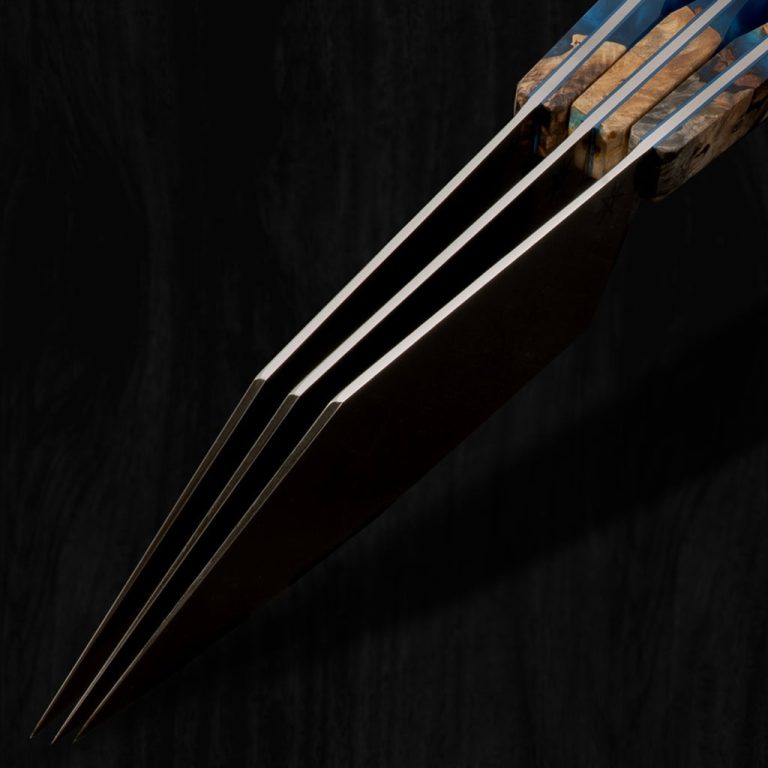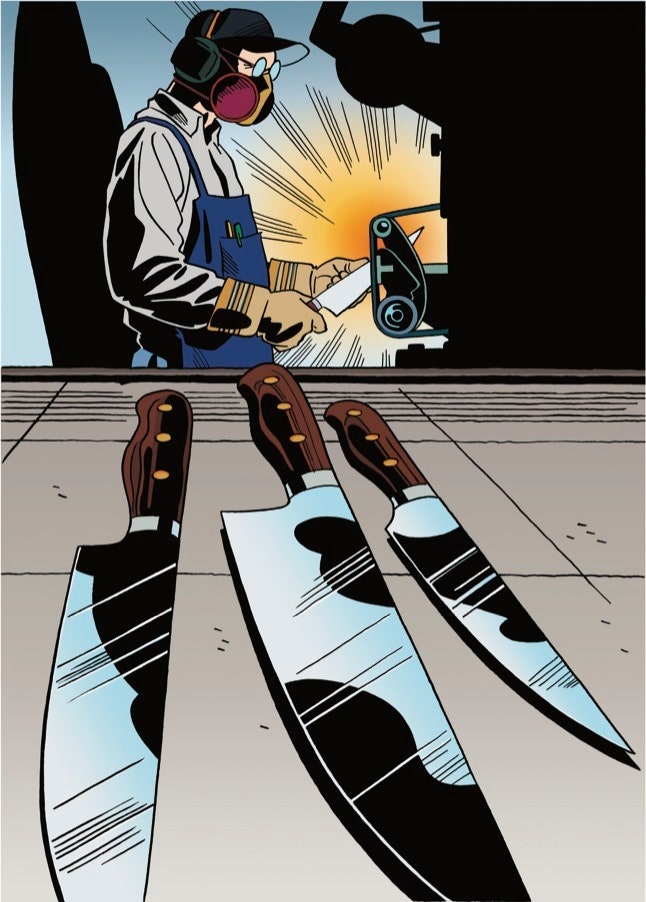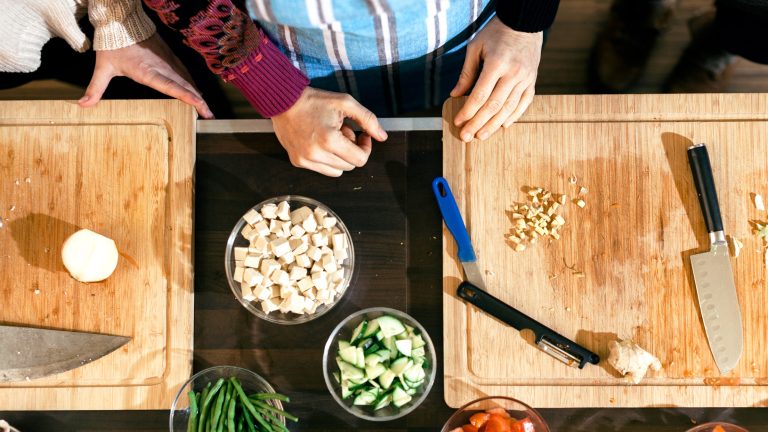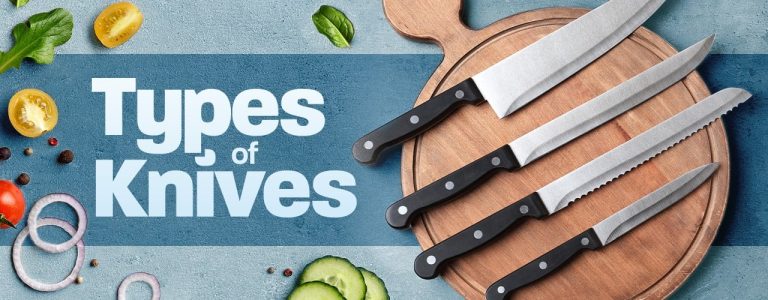Field Dressing Game: Using Hunting Knives Effectively
Field dressing game effectively requires using hunting knives with precision and skill to ensure clean and efficient processing. Proper technique and knowledge of the animal’s anatomy are crucial for a successful field dressing process.
By utilizing sharp, high-quality hunting knives and following step-by-step instructions, hunters can effectively remove the animal’s internal organs, skin, and other unwanted parts, preserving the meat for consumption. The process begins with choosing the right knife and maintaining its sharpness, allowing for clean cuts and preventing the meat from being tainted.
It is important to understand the importance of field dressing game and the role that hunting knives play in this process, as it contributes to the overall success and enjoyment of the hunting experience.
Credit: pumaknifecompanyusa.com
The Importance Of A Sharp Hunting Knife
A sharp hunting knife is crucial for effectively field dressing game. It allows hunters to complete the task efficiently, ensuring clean cuts and minimizing waste.
Field dressing game is an essential skill for hunters, and having a sharp hunting knife is crucial for this task. A sharp knife not only makes the field dressing process more efficient but also ensures a clean and precise cut, avoiding unnecessary damage to the game.
In this section, we will explore the role of a sharp knife in field dressing game, the benefits of using a sharp hunting knife, and how to maintain its sharpness.
The Role Of A Sharp Knife In Field Dressing Game:
- A sharp hunting knife allows for quick and effortless cuts, reducing the time spent on field dressing. With a dull knife, you might struggle to make clean cuts, which can be frustrating and time-consuming.
- Using a sharp knife minimizes tissue damage during field dressing. A dull knife can tear tissue, leading to bloodshot meat and an unpleasant taste. On the other hand, a sharp knife cleanly separates the skin from the game, making the process more hygienic.
- A sharp knife results in better control and precision. When field dressing game, it is essential to navigate around organs and bones. A sharp knife allows you to perform delicate cuts with accuracy, avoiding any accidental punctures or damage.
- With a sharp hunting knife, you can effortlessly field dress different sizes of game. Whether you are dealing with a small bird or a large deer, a sharp knife ensures you have the cutting power necessary for a successful field dressing session.
Benefits Of Using A Sharp Hunting Knife:
- Improved safety: Using a sharp hunting knife reduces the risk of accidents caused by excessive force or slipping. A sharp blade requires less pressure, providing a safer and more controlled cutting experience.
- Enhanced efficiency: A sharp knife helps you work more efficiently, minimizing fatigue and achieving cleaner cuts in less time. This allows you to complete the field dressing process swiftly, maximizing the quality of the game.
- Higher quality meat: By using a sharp hunting knife, you can maintain the integrity of the meat. Clean, precise cuts prevent unnecessary tissue damage and preserve the flavor and texture of the meat. This ensures a more enjoyable dining experience.
- Professional appearance: When it comes to field dressing game, using a sharp knife displays your level of expertise and professionalism. It conveys that you take the necessary precautions and have the right tools for the job.
Maintaining The Sharpness Of Your Hunting Knife:
- Regular honing: Honing your hunting knife helps maintain its sharpness by realigning the edge. Use a honing rod or a sharpening stone to gently swipe the blade along its length, following the knife’s bevel angle. Repeat this process periodically, especially after each use.
- Proper storage: Storing your hunting knife correctly is vital for preserving its sharpness. Avoid leaving it in humid environments or in contact with other metal objects that can cause nicks or dullness. Consider using a protective sheath or pouch to prevent accidental damage.
- Sharpening when necessary: Despite honing, your hunting knife will eventually require sharpening to regain its full sharpness. Use a sharpening stone or a knife sharpening system to restore the knife’s edge. Follow the manufacturer’s instructions and take your time to achieve optimal results.
By recognizing the importance of a sharp hunting knife in field dressing game, understanding the benefits it brings, and practicing proper maintenance, you can enhance your hunting experience and ensure the best possible outcome when preparing your harvest. Remember, a sharp knife is not only a valuable tool but also a testament to your skill and care as a hunter.
Choosing The Right Type Of Hunting Knife
Choosing the right hunting knife for field dressing game is essential for effective hunting. Ensure the knife is sharp, durable, and easy to handle, allowing for efficient and precise cuts.
Understanding Different Hunting Knife Blade Types
- Fixed Blade: This type of hunting knife has a solid, non-folding blade that is reliable and sturdy. It is perfect for heavy-duty tasks like field dressing game. The blade stays securely in place, ensuring safety during use.
- Folding Blade: A folding hunting knife is compact and portable, with a blade that folds into the handle. It is convenient for carrying in your pocket or backpack. However, folding blades are not as robust as fixed blades and may require additional maintenance.
- Skinning Blade: Skinning knives are designed specifically for removing the hide from game. They typically have a curved blade with a sharp and narrow tip. The curved shape allows for precise and efficient skinning.
- Gut Hook Blade: Gut hooks are small, semi-circular hooks located on the spine of a hunting knife. They are used for opening the abdomen of game animals while minimizing the risk of puncturing organs. Gut hooks can make the field dressing process quicker and more efficient.
- Drop Point Blade: The drop point blade is a versatile option for field dressing game. It has a strong, curved spine that drops down to meet the point of the knife, creating a broad, sturdy tip. This blade type is excellent for detailed and controlled cutting.
Factors To Consider When Choosing A Hunting Knife
When selecting a hunting knife, take these factors into account:
- Blade Material: Opt for high-quality stainless steel or carbon steel blades, as they offer durability and excellent cutting performance. Stainless steel is resistant to corrosion, while carbon steel holds a sharper edge but requires more maintenance.
- Blade Length: Consider the length of the blade based on the game you typically hunt. A shorter blade, around 2-4 inches, is suitable for small game, while a longer blade, around 4-6 inches, is better for larger animals.
- Handle Design: Look for a hunting knife with a comfortable and ergonomic handle. Choose a material like rubber, G10, or micarta that provides a secure grip even in wet conditions.
- Knife Weight: Find a balance between weight and functionality. Too heavy a knife may be cumbersome, while an overly lightweight knife may lack durability.
- Sheath Quality: The sheath is essential for carrying and protecting your hunting knife. Opt for a durable and secure sheath that allows for easy access and safe storage.
Best Hunting Knife Brands And Models For Field Dressing Game
When it comes to hunting knives, these brands and models are popular among hunters for their quality, reliability, and functionality:
- Buck Knives Alpha Hunter: This fixed blade hunting knife has a drop point blade crafted from high-quality stainless steel. It offers excellent edge retention and is ideal for field dressing game.
- Gerber StrongArm: The StrongArm features a fixed, full tang blade made of high carbon stainless steel. It includes a versatile diamond-texture rubber handle for a sure grip in various weather conditions.
- Benchmade Hidden Canyon Hunter: This small, fixed blade hunting knife boasts a durable CPM-S30V stainless steel blade. Its compact size and precise cutting performance make it perfect for field dressing game.
- Havalon Piranta Edge: The Piranta Edge is a folding hunting knife with a replaceable surgical-grade stainless steel blade. It offers exceptional sharpness and ease of maintenance.
- Outdoor Edge RazorLite: This folding hunting knife features a replaceable, razor-sharp stainless steel blade. The blade can be easily changed for a fresh edge when needed, ensuring optimal cutting performance.
Remember, choosing the right hunting knife depends on personal preference, the type of game you hunt, and the tasks you need to accomplish in the field. Consider these factors and the reputation of different brands to find the hunting knife that best suits your needs.
Proper Techniques For Field Dressing Game
Discover the proper techniques for field dressing game by effectively using hunting knives. Learn how to handle various animals and ensure efficient and clean dressing for a successful hunting experience.
Field dressing game is an essential skill for hunters. Properly using hunting knives is crucial to ensure the safety of both the hunter and the game, as well as to preserve the quality of the meat. In this section, we will provide a step-by-step guide to field dressing game, along with important tips and techniques to follow.
Step-By-Step Guide To Field Dressing Game:
- Assessing the Situation and Ensuring Safety:
- Before starting the field dressing process, carefully evaluate the terrain and any potential hazards.
- Always wear appropriate protective gear, including gloves and eye protection, to minimize the risk of injury and contamination.
- Make sure your hunting knife is clean, sharp, and properly secured to prevent accidents.
- Making Initial Incisions and Removing the Hide:
- Locate the anus and carefully make a small incision around it, being cautious not to puncture any internal organs.
- Extend the incision towards the sternum, along the belly of the animal.
- Use your fingers or a specialized gut hook on your hunting knife to carefully separate the hide from the underlying tissue.
- Pull the hide away from the body, using your knife to make any necessary cuts along the way.
- Removing Organs and Preparing for Butchering:
- Begin by removing the internal organs, starting with the diaphragm and working your way towards the back of the animal.
- Be careful not to damage any vital organs or contaminate the meat with digestive fluids.
- Cut through the rib cage, allowing access to the organs without puncturing them.
- Remove the windpipe and esophagus, as well as any other organs, by carefully cutting and separating them from the carcass.
- Rinse the cavity with clean water to remove any remaining blood or debris.
Common Mistakes To Avoid During Field Dressing:
- Improper Handling of the Hunting Knife:
- Failing to maintain a firm grip on the hunting knife can lead to accidents and injuries.
- Using a dull knife or applying excessive force can result in loss of control and potential harm.
- Damaging Important Organs or Meat:
- Careless cuts or punctures to vital organs can render the meat inedible or unhealthy to consume.
- Ensure precise and controlled movements to avoid accidentally damaging the heart, lungs, or other essential organs.
- Ineffective Field Dressing Techniques:
- Rushing through the field dressing process can compromise the quality of the meat and increase the risk of contamination.
- Following proper techniques, such as using clean tools and minimizing contact with the ground, is vital for food safety.
By following these proper techniques and avoiding common mistakes, hunters can efficiently field dress game and ensure the preservation of high-quality meat. Remember, practice and experience will enhance your field dressing skills over time. Stay safe and enjoy the process of turning your hunt into flavorful meals.
Safety Tips For Using Hunting Knives
Field dressing game effectively requires following safety tips for using hunting knives. Learn how to handle and maintain your knife, use proper cutting techniques, and prioritize safety to enhance your hunting experience.
Field dressing game can be a challenging yet necessary task for hunters. One of the most essential tools for field dressing is the hunting knife. However, it is crucial to use hunting knives safely to prevent accidents and injuries. In this section, we will explore some important safety tips for effectively using hunting knives.
Essential Safety Precautions When Using Hunting Knives
- Always handle hunting knives with care to prevent accidental cuts or injuries.
- Keep your fingers away from the blade and handle the knife with a firm grip.
- Make sure your hunting knives are sharp. Dull blades can cause slips and accidents.
- Use the appropriate hunting knife for each task. Different blades are designed for specific purposes such as skinning, gutting, or caping.
- Avoid using hunting knives in compromised positions or environments, such as unstable surfaces or crowded areas.
- Keep your hunting knives clean and free from dirt, blood, or other debris that might impair your grip or cause slips.
- Be cautious when passing or receiving a hunting knife to someone else. Make sure the handle is securely held before letting go.
- Always store hunting knives in a sheath or protective cover when not in use to prevent accidental cuts.
Correct Knife Handling Techniques
- Use proper cutting techniques when using hunting knives. Keep your fingers clear of the cutting path and use a controlled motion.
- Maintain a stable and balanced stance when wielding a hunting knife to ensure accuracy and reduce the risk of tripping or losing control.
- Keep your focus on the task at hand when using hunting knives. Distractions can increase the likelihood of accidents.
- Avoid using excessive force when using a hunting knife. Let the blade do the work, applying gentle pressure in a controlled manner.
- Never use a hunting knife for unintended purposes, such as prying or scraping. This could lead to damage or breakage.
Knife Care And Maintenance To Prevent Accidents
- Regularly clean and oil your hunting knives to prevent rust formation and maintain the blade’s integrity.
- Store hunting knives in a safe and secure location, out of the reach of children or unauthorized individuals.
- Inspect hunting knives before each use. Check for any signs of damage or wear that might compromise the knife’s performance or safety.
- Sharpen hunting knives as needed to ensure optimal cutting efficiency and reduce the risk of slips or accidents due to dullness.
- Always follow the manufacturer’s instructions and recommendations for proper care and maintenance of your hunting knives.
By following these safety tips and techniques, hunters can effectively and safely use their hunting knives during the field dressing process. Remember, prioritizing safety is crucial to avoid accidents and enjoy a successful hunting experience.
Key Tools And Accessories For Field Dressing Game
Discover the essential tools and accessories for successfully field dressing game, with a focus on the effective use of hunting knives. Enhance your hunting experience with these key items.
Field dressing game is an essential skill for every hunter. It involves removing the internal organs and preparing the animal for consumption. To accomplish this task effectively, there are several key tools and accessories that you should have at your disposal.
In this section, we will discuss these must-have tools and accessories, including knife sharpeners and honing tools, as well as proper storage and transport of hunting knives.
Must-Have Tools And Accessories For Effective Field Dressing:
- Knife Sharpeners and Honing Tools:
- Keeping your hunting knife sharp is crucial for efficient field dressing. A dull blade can make the process more difficult and potentially dangerous. Invest in quality knife sharpeners and honing tools to ensure your blade remains in top condition.
- Regularly sharpen your knife using a sharpening stone or a sharpening system specifically designed for hunting knives. This will help maintain a razor-sharp edge, allowing for clean and precise cuts.
- Honing rods can also be handy for touch-ups during field dressing. They help realign the edge of the blade, keeping it sharp for longer periods.
- Proper Storage and Transport of Hunting Knives:
- After field dressing game, it is important to properly store and transport your hunting knife to maintain its quality and safety. Consider the following tips:
- Clean your knife thoroughly with warm water and mild soap to remove any dirt, blood, or debris. Dry it thoroughly to prevent rusting.
- Apply a thin coat of oil on the blade to protect it from moisture and corrosion.
- Use a sheath or knife case to store your hunting knife when not in use. This will prevent accidental injuries and protect the blade.
- When transporting your hunting knife, make sure it is safely secured to avoid any potential accidents.
Having the right tools and accessories for field dressing game is essential for a successful hunting experience. Remember to regularly sharpen your knife and utilize honing tools to maintain a sharp edge. Additionally, properly store and transport your hunting knife to keep it in optimal condition.
By following these guidelines, you can ensure efficient field dressing and prolong the lifespan of your hunting knife.
Cleaning And Maintaining Hunting Knives
Maintaining hunting knives is essential for effective field dressing of game. Regular cleaning and proper maintenance ensure optimal performance and longevity, keeping hunters prepared for successful outings.
Field Dressing Game: Using Hunting Knives Effectively
Field dressing game is an essential skill for every hunter, and having a reliable hunting knife is crucial to make the task efficient and effective. However, simply owning a hunting knife is not enough; you must also know how to clean and maintain it properly.
With regular cleaning and upkeep, you can ensure that your hunting knife remains in top condition, ready to assist you in the field. In this section, we will explore the best practices for cleaning and maintaining your hunting knife, including sanitizing, preventing rust and corrosion, and long-term maintenance tips.
How To Clean And Sanitize Your Hunting Knife
Cleaning and sanitizing your hunting knife is of utmost importance to prevent the growth of bacteria, maintain its functionality, and ensure your safety. Follow these steps to effectively clean and sanitize your hunting knife:
- Rinse the blade: Using warm water, rinse off any dirt, blood, or debris on the blade. Make sure to remove all visible residue.
- Use mild soap: Apply a small amount of mild soap directly to the blade. Using a soft cloth or sponge, gently scrub the blade to remove any remaining stains or grime.
- Dry thoroughly: After cleaning, ensure that your hunting knife is completely dry. Use a clean, dry cloth to remove any moisture on the blade or handle.
- Apply a lubricant: To protect your hunting knife from rust and corrosion, apply a thin layer of lubricant or oil to the blade. This will help maintain its longevity and performance.
- Store properly: Always store your hunting knife in a dry environment to prevent moisture buildup. Consider using a sheath or knife case to protect the blade and handle from damage.
Preventing Rust And Corrosion
Rust and corrosion can significantly damage your hunting knife, rendering it ineffective and potentially unsafe. To prevent rust and corrosion, follow these tips:
- Avoid moisture exposure: Moisture is the primary cause of rust and corrosion. Keep your hunting knife dry and away from any wet or humid environments.
- Clean after each use: Immediately clean your hunting knife after each use to remove any blood, dirt, or moisture that may have accumulated.
- Remove fingerprints: Oily fingerprints can also lead to rust formation. Wipe down the blade and handle regularly to remove any fingerprints or oils.
- Apply rust inhibitors: Consider using a rust inhibitor or corrosion-resistant spray on your hunting knife to provide an extra layer of protection against these elements.
- Regular maintenance: Regularly inspect your hunting knife for signs of rust or corrosion. If you notice any, clean and treat it immediately to prevent further damage.
Long-Term Maintenance Tips For Hunting Knives
Proper long-term maintenance of your hunting knife can extend its lifespan and keep it performing at its best. Here are some useful tips for long-term knife maintenance:
- Sharpen regularly: Keep your hunting knife sharp by regularly sharpening the blade. This will ensure clean and precise cuts, making field dressing easier.
- Check for loose or damaged parts: Periodically inspect your hunting knife for loose screws, cracked handles, or other signs of damage. Address any issues promptly to prevent further deterioration.
- Use in a suitable manner: Avoid using your hunting knife for tasks other than field dressing game. Using it for prying, cutting hard objects, or any other inappropriate use can lead to damage.
- Avoid extreme temperatures: Extremes in temperature can affect the integrity of your hunting knife. Store it in a temperature-controlled environment and avoid exposing it to direct sunlight or extreme cold.
- Seek professional maintenance if needed: If you are unsure about any specialized maintenance needs or if your hunting knife requires professional attention, consult a knowledgeable knife expert or specialist.
Remember, taking care of your hunting knife is not only essential for maintaining its functionality but also for ensuring your safety while field dressing game. By following these cleaning and maintenance tips, you can keep your hunting knife in excellent condition, ready for your next hunting adventure.
Frequently Asked Questions On Field Dressing Game: Using Hunting Knives Effectively
What Is The Best Hunting Knife For Field Dressing A Deer?
The ideal hunting knife for field dressing deer is a compact, sharp, and durable knife with a non-slip handle.
How Big Of A Knife Do I Need For Field Dressing Deer?
For field dressing deer, a knife with a blade size around 4-5 inches would be sufficient.
What Should You Avoid Cutting Or Puncturing When Field Dressing An Animal?
Avoid cutting or puncturing the internal organs or intestines of the animal when field dressing.
What Is The Best Knife Shape For Gutting Deer?
The best knife shape for gutting deer is a drop point blade due to its versatility and precision.
Conclusion
Hunting knives play a crucial role in effective field dressing game. By choosing the right knife for the job and employing proper techniques, hunters can ensure a successful and efficient process. Remember to opt for high-quality, durable knives that are specifically designed for field dressing.
Maintaining and sharpening your knife regularly will prolong its lifespan and ensure optimal performance. Take the time to familiarize yourself with proper cutting techniques and safety precautions to prevent accidents and injuries. Being mindful of cleanliness and hygiene is also key, as it minimizes the risk of contamination and the spread of diseases.
Overall, hunting knives are indispensable tools for hunters, and when used effectively, they enhance the experience and contribute to a successful hunt. Happy hunting!






